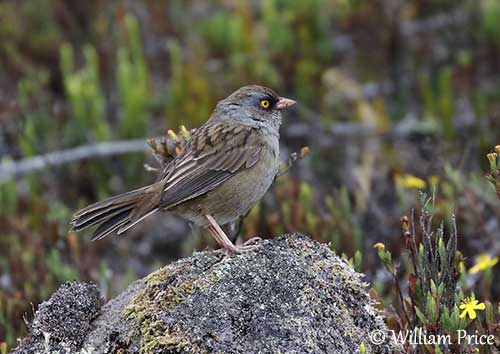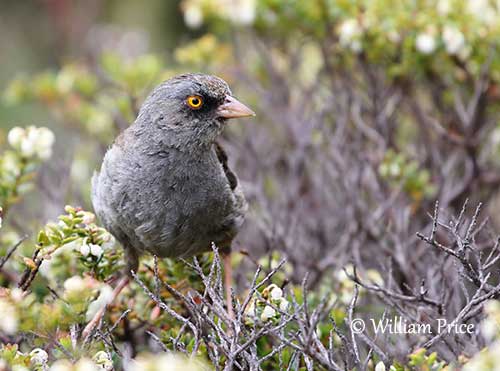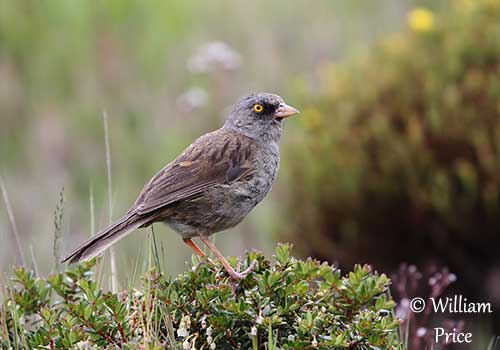
PROTECTION / THREATS / STATUS:
The Volcano Junco has restricted range where it is described as uncommon to locally fairly common.
The size of the population is unknown, but it is suspected to be stable.
The Volcano Junco may benefit from deforestation, creating more open habitat. In the future, the habitat at high elevations may be affected by global climate change, involving habitat loss for this species.
But currently, the Volcano Junco is not globally threatened and evaluated as Least Concern.
Fr: Junco des volcans
Ang: Volcano Junco
All: Streifenwinterammer
Esp: Junco de los Volcanes
Ita: Junco dei vulcani
Nd: Vulkaanjunco
Sd: vulkanjunco
Photographer:
William Price
PBase-tereksandpiper & Flickr William Price
Text by Nicole Bouglouan
Sources:
HANDBOOK OF THE BIRDS OF THE WORLD Vol 16 by Josep del Hoyo- Andrew Elliot-David Christie – Lynx Edicions – ISBN: 9788496553781
Birds of Costa Rica: A Field Guide De Carrol L. Henderson, Steve Adams – Editeur: University of Texas Press, 2010 – ISBN: 0292719655, 9780292719651-387 pages
A Guide to the Identification and Natural History of the Sparrows of the United States and Canada – Editeur: Bloomsbury Publishing, 2010 – ISBN: 1408135191, 9781408135198 – 379 pages
Buntings and Sparrows Par Clive Byers, Urban Olsson, Jon Curson – Editeur : A&C Black, 2013 – ISBN: 1408189062, 9781408189061 – 264 pages
Neotropical Birds – Cornell Lab of Ornithology
Wikipedia, the free encyclopaedia
Volcano Junco
Junco vulcani
Passeriformes Order – Passerellidae Family
INTRODUCTION:
The Volcano Junco of family Passerellidae is found in the highlands of Costa Rica and W Panama. It is a restricted-range species usually found around volcanoes. The distribution is rather fragmented with the preferred habitat confined to mountain tops.
The Volcano Junco forages mainly on the ground and feeds on insects and spiders, but also on seeds and berries. It is often seen alone or in pairs, and also in family groups according to the season. The nest is usually placed on the ground, protected by rock or vegetation.
The Volcano Junco is described as locally fairly common and the species is not globally threatened for the moment.
DESCRIPTION OF THE BIRD:
Biometrics:
Length: 15-17 cm
Weight: 28 g
Unlike other Junco species, the Volcano Junco lacks white on the tail.
On the upperparts, the upper mantle is olive-brown with indistinct dark streaks. Lower mantle to uppertail-coverts is duller olive-brown with dark streaking on lower mantle, back and scapulars. On the tail, the dusky feathers show narrow, greyish edges, whereas the outer rectrices have grey tips. On the blackish-brown upperwing, primaries and secondaries are narrowly edged grey-brown. Wing-coverts and tertials show broad, tawny-brown edges.

The underparts are grey with olive-buff wash, mainly on flanks and vent. The chin is speckled black, whereas the throat may appear slightly paler grey.
On the head, the crown is olive-brown with indistinct dark streaking. Head sides and supercilium are grey. Lores and eye’s area are black.
The conical, pointed bill is pale pinkish. The eyes are yellow to yellow-orange. Legs and feet are pale pinkish-grey.
Male and female are similar.
The juvenile shows more reddish on the upperparts with more streaking. The underparts are buff with brown streaking, but centre of belly is uniformly buff. The eyes are dark brown at first.
RANGE:
The Volcano Junco is found in the highlands of Costa Rica and W Panama. It occurs in the E of Cordillera Central of Costa Rica, S to Volcán Barú in Chiriquí, W Panama.
There is an isolated population in Sabana Dúrika, Costa Rica, at 2,100 metres of elevation.
HABITAT:
The Volcano Junco frequents open grassy or brushy areas of páramo, also stunted scrub produced by eruptions, second growth, bamboo thickets, overgrown pastures and roadsides.
The species typically occurs above 3,000 metres of elevation above the treeline, but forest clearance on Cerro de la Muerte in Costa Rica has allowed the species to descend to 2,600 metres.

CALLS AND SONGS: SOUNDS BY XENO-CANTO
The calls of the Volcano Junco include a high, thin “tsee”, a scolding “whew” or “jeew”, a repeated “tchip” when excited, and a fast series “cher-we cher-we cher-we…”
The song is mostly weak, with squeaky, burbling or buzzy notes. It is described as “k’cheew, chee k’wee, chip-chip ts’chew tsi’weet…”
BEHAVIOUR IN THE WILD:
The Volcano Junco is mainly terrestrial, hopping and running along the ground among the vegetation while searching for prey such as small insects and spiders, but also seeds and fallen berries.
It is often seen alone, in pair or in family group. It is probably territorial and often seen in pairs, indicating that this species is presumably socially monogamous.
The cup-shaped nest is built on the ground, under rock or vegetation.
The Volcano Junco is sedentary, with little or no altitudinal movements.
The fluttering flight is laboured and weak. This species flies only over short distances.
REPRODUCTION OF THIS SPECIES:
The breeding season takes places from March to July.
The Volcano Junco nests on the ground. The cup-shaped structure is placed under log, rock or bush, or in a cavity on a mossy bank. It is made with grass stems and lined inside with vegetal down, often fluff from thistle, and animal hair. The cup is sometimes decorated with moss outside.
The female lays 2 pale blue eggs with dark dots around the large end.
Nothing is known about incubation, parental care and nestling development.
